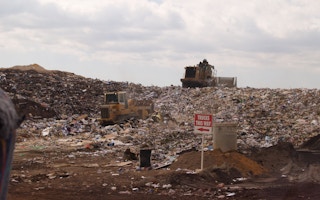Australia contributes 1.3 per cent to global greenhouse gas emissions and various voices in the Liberal-National coalition government are saying that is so small we don’t need to act, or don’t need to act faster, to reduce emissions because the adverse economic impacts are not worth it. I don’t buy that argument. Reducing emissions does not mean destroying jobs and the economy. It means growing jobs and economic wealth in different parts of the economy.
To continue reading, subscribe to Eco‑Business.
There's something for everyone. We offer a range of subscription plans.
- Access our stories and receive our Insights Weekly newsletter with the free EB Member plan.
- Unlock unlimited access to our content and archive with EB Circle.
- Publish your content with EB Premium.
Let’s look at the recycling and waste industry as an example.
The waste and recycling industry contributes close to 3 per cent of Australia’s direct emissions, essentially from methane leakage from landfills and carbon-dioxide emissions from trucks. In 1996 it emitted 16 million tonnes of CO2-equivalent, had a recycling rate of 6 per cent of waste generated, and employed 30,000 people.
In 2019 it had an emission footprint of 10 million tonnes of CO2-e (a decrease of almost 40 per cent), achieved a recycling rate of 58 per cent and employed 56,000 people.
How did it achieve a 40 per cent reduction in emissions while growing jobs, economic wealth and improving recycling rates?
By embedding the costs of climate change in the economic decisions of waste generators. Simply put, regulators placed a carbon price on the waste we sent to landfill.
This was done both directly via the carbon “tax” of former prime minister Julia Gillard (though it was never a tax but a fixed price trading scheme) and indirectly by the state governments in the form of the landfill levies.
The effect has been significant.
Firstly, the carbon pricing mechanism encouraged landfill owners to install gas capture systems to reduce fugitive methane emissions from landfills. Methane is a potent greenhouse gas with a global warming potential of 25 times that of carbon dioxide. Put simply, every tonne of methane emitted from a landfill is equivalent to emitting 25 tonnes of carbon dioxide. Organics in landfill decompose anaerobically to generate methane.
As a result of the carbon price, every landfill in Australia emitting over 25,000 tonnes of CO2‑e per year has installed a landfill gas capture system. That single arrangement reduced landfill greenhouse emissions by at least 6 million tonnes per year.
The biggest challenge remains the cumulative emissions from small landfills and the continuing fugitive emissions from large landfills (around the edges of the landfill, cracks and the long-tail emissions after it has ceased operating). With the axing of the carbon price there is a much reduced commercial incentive to improve gas capture. So fugitive emissions have continued.
The second key mechanism hasn’t come from the federal government but from the states. The state landfill levies are an indirect price on the “externalities” of landfill. That is, they are an attempt to price the unintended consequences of landfilling our waste including odour, loss of resources, emissions, traffic, dust and the opportunity cost of not being able to recycle these products back into the productive economy.
State landfill taxes now range from A$0 (Northern Territory, Tasmania and Australian Capital Territory) to A$140 (New South Wales and South Australia), with Victoria, Queensland and Western Australia in between. They are the key driver of the significant growth in recycling rates across the country. And most important, the levy is only paid on waste to landfill. In the same way a carbon price would work, the levy is completely avoided if the material is recycled. If you don’t cause pollution, you don’t pay the price.
And this is where I need to discuss the significant indirect emissions reductions derived from recycling.
While the direct emissions from the waste sector are 10 million tonnes (from landfill methane emissions), the indirect benefits of recycling are much bigger. The fact is that recycling sends useful products back to industry and by avoiding the extraction of raw materials, it massively reduces associated greenhouse gas emissions. If we recycle, we don’t need to mine, transport and process the equivalent raw materials. These processes can be very energy- and emissions-intensive especially for products like aluminium, steel, glass and plastic.
So by recycling we are capturing the embodied energy of the recovered materials. That is the energy that went into making the plastic, glass, steel or aluminium in the first place.
In fact, recycling currently reduces the direct emissions of other manufacturing activities by at least 50 million tonnes of CO2‑e per year. That is, 50 million tonnes more emissions that glass factories, aluminium smelters, steel smelters, paper mills etc would be emitting if they did not have access to the recycled product.
So, if we were to stop recycling, emissions would go up by 50 million tonnes of CO2‑e. That is 10 per cent of Australia’s national emissions of 533 million tonnes. (I must note that some of this material is exported so it shows up in emission reduction accounts in other countries—but climate change doesn’t care where the emissions occur, just that they do).
So, state government landfill levies have significantly reduced Australia’s emission footprint and contributed to global emission reduction of at least 50 million tonnes of CO2‑e so far.
Which brings me to future emission reductions. We currently achieve a 58 per cent national recycling rate. What if we could do even better?
Work done by sustainability consultancy Warnken ISE and MRA, more recently, shows that Australia could achieve at least a further 50 million tonnes of CO2‑e emissions reduction by expanding recycling and introducing energy-from-waste. Four simple and cost-effective actions are required:
- Divert organics from landfill and into compost for farmers—to reduce landfill methane generation and facilitate soil carbon storage
- Expand recycling to avoid emissions associated with mining and manufacturing new materials
- Expand energy-from-waste to displace fossil fuels, capture the embodied energy of non-recyclable materials and avoid emissions
- Increase landfill gas capture to capture the remaining direct landfill emissions
These four actions would reduce Australia’s greenhouse emissions by 10 per cent, or over one-third of the country’s Paris Agreement commitment to reduce emissions by 26 to 28 per cent from business-as-usual levels.
Put another way, if we expanded recycling, captured fugitive landfill emissions, introduced energy-from-waste and banned organics to landfill, we could avoid another 50 million tonnes currently emitted by other sectors. (These savings also do not include the massive greenhouse gas benefits of sequestering organics in soil via compost and biochar).
Not only would that massively reduce our contribution to global greenhouse emissions, it would generate at least an additional 50,000 new jobs and a huge variety of new businesses. That will drive economic growth and resource conservation.
So the idea that reducing emissions necessarily stifles economic growth and destroys jobs is simply not correct.
We can create a more sustainable Australia by reducing emissions, increasing recycling and growing new green jobs. Simple.
It just requires political will and the courage to take the next step.
We shouldn’t need more disasters to make this transition happen.
Mike Ritchie is managing director of MRA Consulting Group, an environmental consultancy in Australia that specialises in business and policy reform. He was national vice-president and NSW president of the Waste Management Association of Australia.









